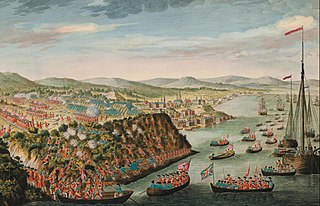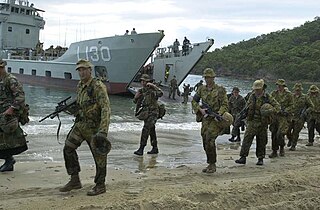
USS Peleliu (LHA-5) is a Tarawa-class amphibious assault ship of the United States Navy, named for the Battle of Peleliu of World War II. Entering service in 1980, she has been deployed to the Persian Gulf on several occasions, performed an evacuation of U.S. Naval Base Subic Bay following the eruption of Mount Pinatubo, operated with the INTERFET peacekeeping taskforce, participated in Pacific Partnership deployments, and provided assistance following the massive floods in Pakistan in 2010. She was decommissioned in San Diego, California on March 31, 2015. She currently rests, out of commission and in reserve, at NAVSEA Inactive Ships On-site Maintenance Office, Pearl Harbor, Hawaii alongside USS Tarawa in the inactive reserve in case of further need.

USS Tarawa (LHA-1) is a United States Navy amphibious assault ship, the lead ship of her class, and the second ship to be named for the Battle of Tarawa fought during World War II. Tarawa was decommissioned on 31 March 2009, at San Diego Naval Base.

The Seventh Fleet is a numbered fleet of the United States Navy. It is headquartered at U.S. Fleet Activities Yokosuka, in Yokosuka, Kanagawa Prefecture, Japan. It is part of the United States Pacific Fleet. At present, it is the largest of the forward-deployed U.S. fleets, with 60 to 70 ships, 300 aircraft and 40,000 Navy, Marine Corps personnel, and Coast Guard support personnel. Its principal responsibilities are to provide joint command in natural disaster or military operations and operational command of all US naval forces in the region.

HMS Albion is an amphibious transport dock of the Royal Navy, the first of the two-ship Albion class. Built by BAE Systems Marine in Barrow-in-Furness, Albion was launched in March 2001 by the Princess Royal. Her sister ship, Bulwark, was launched in November 2001, also from Barrow. Affiliated to the city of Chester and based in Plymouth, she is the ninth ship to carry the name Albion, stretching back to the 74-gun 1763 warship, and last carried by an aircraft carrier decommissioned in 1973 after 19 years service. Designed as an amphibious warfare ship, Albion carries troops, normally Royal Marines, and vehicles up to the size of the Challenger 2 main battle tank. She can deploy these forces using four Landing Craft Utility (LCUs) and four Landing Craft Vehicle and Personnel (LCVPs). A flight deck supports helicopter operations.

The Bay class is a ship class of four dock landing ships built for the British Royal Fleet Auxiliary (RFA) during the 2000s. They are based on the Dutch-Spanish Royal Schelde Enforcer design, and replaced the Round Table-class logistics ships. Two ships each were ordered from Swan Hunter and BAE Systems Naval Ships. Construction work started in 2002, but saw major delays and cost overruns, particularly at Swan Hunter's shipyard. In mid-2006, Swan Hunter was stripped of work, and the incomplete second ship was towed to BAE's shipyard for completion. All four ships, Largs Bay, Lyme Bay, Mounts Bay, and Cardigan Bay had entered service by 2007.

HMS Challenger was a Royal Navy diving support vessel, operational from 1984 to 1990.

RIMPAC, the Rim of the Pacific Exercise, is the world's largest international maritime warfare exercise. RIMPAC is held biennially during June and July of even-numbered years from Honolulu, Hawaii, with the exception of 2020 where it was held in August. It is hosted and administered by the United States Navy's Indo-Pacific Command, headquartered at Pearl Harbor, in conjunction with the Marine Corps, the Coast Guard, and Hawaii National Guard forces under the control of the Governor of Hawaii. The US invites military forces from the Pacific Rim and beyond to participate. With RIMPAC the United States Indo-Pacific Command seeks to enhance interoperability among Pacific Rim armed forces, as a means of promoting stability in the region to the benefit of all participating nations. It is described by the US Navy as a unique training opportunity that helps participants foster and sustain the cooperative relationships that are critical to ensuring the safety of sea lanes and security on the world's oceans.

Amphibious warfare is a type of offensive military operation that today uses naval ships to project ground and air power onto a hostile or potentially hostile shore at a designated landing beach. Through history the operations were conducted using ship's boats as the primary method of delivering troops to shore. Since the Gallipoli Campaign, specialised watercraft were increasingly designed for landing troops, material and vehicles, including by landing craft and for insertion of commandos, by fast patrol boats, zodiacs and from mini-submersibles.

USS Germantown (LSD-42) is the second Whidbey Island-class dock landing ship in the United States Navy. She is the second navy ship named after the Revolutionary War Battle of Germantown.

Newport-class tank landing ships were an improved class of tank landing ship (LST) designed for and employed by the United States Navy from 1969 to 2002. The ships were intended to provide substantial advantages over their World War II-era predecessors. Larger and faster than any previous LST design, they carried a ramp over the bow that allowed them to surpass 20 knots, a goal of the United States amphibious forces. 27 were planned of which twenty were completed, the high number due to the demands of US force projection estimates. However, the arrival of the air-cushioned landing craft which allowed for over-the-horizon attacks made the class obsolete in the eyes of the United States Navy. Placed in reserve, twelve were eventually sold to foreign navies, while the remaining eight have since been decommissioned.

The Canberra class is a ship class of two landing helicopter dock (LHD) ships built for the Royal Australian Navy (RAN). Planning to upgrade the navy's amphibious fleet began in 2000, based on Australian experiences leading the International Force for East Timor peacekeeping operation. With a new climate for growing Australian Navy spending, a desire existed for forward defence capability for landing and supporting troops on Asian territory, that had never existed in Australian history, even with the old Majestic-class light fleet carriers, HMAS Melbourne and HMAS Sydney in the 1970s. In 2004, French company Direction des Constructions Navales (DCN) and Spanish company Navantia were invited to tender proposals, with DCN offering the Mistral-class amphibious assault ship and Navantia proposing the "Buque de Proyección Estratégica" design. The Spanish design was selected in 2007, with Navantia responsible for construction of the ships from the keel to the flight deck, and BAE Systems Australia handling the fabrication of the combat and communications systems. Finally, Siemens (Germany) supplied and fitted the azimuth thrusters.
The United Arab Emirates Navy is small force of about 2,500 personnel. It maintains 12 well-equipped coastal patrol boats and eight missile boats. Although primarily concerned with coastal defense, the Navy is constructing a six-unit class of blue water corvettes in conjunction with French shipbuilder CMN. The UAE maintains a small battalion-sized marine force called the UAE Marines equipped with BMP-3 armoured personnel carriers.

The Royal Australian Navy and Australian Army have operated 24 amphibious warfare ships. These ships have been used to transport Army units and supplies during exercises and operational deployments.

The Spearhead-class expeditionary fast transport (EPF) is a United States Navy–led shipbuilding program to provide "a platform intended to support users in the Department of the Navy and Department of the Army. The Expeditionary Fast Transport (EPF) program is a cooperative effort for a high-speed, shallow draft vessel intended for rapid intratheater transport of medium-sized cargo payloads. The EPF will reach speeds of 35–45 knots and will allow for the rapid transit and deployment of conventional or special forces as well as equipment and supplies." The vessels are a part of Military Sealift Command's Sealift Program. The class was previously designated as "Joint High Speed Vessel (JHSV)", but was redesignated in September 2015.

An Expeditionary Transfer Dock (ESD), formerly the Mobile Landing Platform (MLP), are designed to be a semi-submersible, flexible, modular platform providing the US Navy with the capability to perform large-scale logistics movements such as the transfer of vehicles and equipment from sea to shore. These ships significantly reduce the dependency on foreign ports and provide support in the absence of port availability. The class also houses a sub-class variant called the Expeditionary Mobile Base (ESB), formerly the Afloat Forward Staging Base (AFSB).

HMS Protector is a Royal Navy ice patrol ship built in Norway in mid 2000. As MV Polarbjørn she operated under charter as a polar research icebreaker and a subsea support vessel. In 2011, she was chartered as a temporary replacement for the ice patrol ship HMS Endurance and was purchased by the British Ministry of Defence in early September 2013.

HMAS Adelaide (L01) is the second of two Canberra-class landing helicopter dock (LHD) ships of the Royal Australian Navy (RAN). Construction of the ship started at Navantia's Spanish shipyard with steel-cutting in February 2010. The ship was laid down in February 2011, and launched on 4 July 2012. Delivery to Australia for fitting out at BAE Systems Australia's facilities in Victoria was scheduled for 2013, but did not occur until early 2014. Despite construction delays and predictions the ship was commissioned in December 2015.

Australian Border Force Cutter (ABFC) Ocean Shield is an offshore patrol vessel operated by the Australian Border Force. The ship was originally ordered in 2010 by DOF Subsea as an offshore support vessel, and was laid down by STX OSV as MSV Skandi Bergen in 2011. In 2012, the Australian Department of Defence was seeking a short-term replacement for the decommissioned Kanimbla-class amphibious landing ships, and negotiated to purchase the under-construction Skandi Bergen from DOF Subsea. The ship was completed, and entered Royal Australian Navy (RAN) service in mid-2012 as the civilian-crewed Australian Defence Vessel (ADV) Ocean Shield.

















